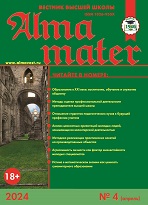UDC 377+378
https://doi.org/10.20339/AM.05-22.043
Olga A. Vagaeva, Cand. Sci. (Pedagogy), Associate Professor of Department “Pedagogics and Psychology” at Penza State Technological University, ORCID: 0000-0003-0161-746X, e-mail: yurmashevj@inbox.ru
Yuliya V. Vel’dina, Cand. Sci. (Pedagogy), Associate Professor of Departament “Foreign languages” at Penza State Technological University, ORCID: https://orcid.org/0000-0002-3217-9872, e-mail: gusarovauvg@yandex.ru
Secondary vocational education is now an important level of training for qualified professionals. It is designed to meet the needs of the individual, society and the state for an education that provides an opportunity to enter the labour market in a fairly short period. Graduates of secondary vocational education institutions often continue their studies at universities, which is due to some reasons.
Our article is to determine how secondary vocational education has become an important part of the multilevel structure in training future specialists, what is the integration of secondary and higher vocational education in the system of their training, what is the reason for students to choose the training programs of secondary vocational education level, whether they work by the specialty obtained in college or not, and what is the reason for them to continue their education in higher educational institutions after completing their studies in secondary vocational institutions.
In order to investigate the questions posed, a survey was conducted among students who have secondary vocational education and are currently enrolled in higher vocational education programs on a part-time basis. 253 students of Penza State Technological University studied in the following fields of study (44.03.04 “Professional Training (within a particular field)”, 09.03.03 “Applied Informatics”, 12.03.04 “Biotechnical Systems and Technologies”, 15.03.05 “Design and Technological Support of Mechanical Engineering Production”, 09.03.02 “Information Systems and Technologies”|, 27.03.02 “Quality Control”, 19.03.01 “Biotechnology”) participated in the survey. This university has been a multilevel educational complex for about 20 years, training students in different fields of training at all existing levels of professional education. The conducted survey allowed evaluating the current state and prospects of development of the phenomenon under study.
The application of a set of complementary theoretical methods will contribute to the solution of the set tasks: analysis, synthesis, generalization, induction, deduction, questionnaire survey, description, the statistical method of processing the materials under study. All these methods will make it possible to analyze already existing scientific knowledge on the issue, as well as to supplement it with new conclusions and findings.
Key words: education, vocational education, integration, professionals, students.
References
1. Current Issues of Secondary Vocational Education System Development in the Russian Federation. URL: http://council.gov.ru/activity/activities/roundtables/114783/ (accessed on: 22.02.22).
2. Batyshev, S.Ya. Methodology of Professional Education Forecasting. In: Professional Education of Russia: Results of the XX Century and Forecasts. Мoscow, 1999. V. 1. P. 56-78.
3. Batyshev, S.Ya. prognostic orientation of professional education. Pedagogy. 1998. No. 6. P. 23–31.
4. Vel’dina Yu.V., Vagaeva O.A. Vocational education’s development factors in the Volga region during the years of the Great Patriotic War. Alma mater (Vestnik vysshei shkoly). 2020. No. 12. P. 106-112. DOI: 10.20339/AM.12-20.106
5. Vel’dina, Yu.V., Vagaeva, O.A. Periodization of training of specialists in the system of Secondary and Higher vocational education in the Volga region (from 1917 up to the early 1960 years). Alma mater (Vestnik vysshei shkoly). 2021. No. 6. P. 110–116. DOI: 10.20339/AM.06-21.110
7. History of Secondary Vocational Education in Russia. S.Y. Batyshev, A.M. Novikov, E.G. Osovsky (eds.). Moscow: Association “Professional Education”, 2003. 672 p.
8. Kurakina, N.S. Issues of Modern Training of Graduates of Secondary Vocational Education. Secondary Vocational Education. 2002. No. 3. P. 42–44.
9. Novikov, A.M. Professional Education in the XXI Century. In: Professional Education of Russia: Results of the XX Century and Forecasts. Moscow, 1999. V. 1. P. 11–22.
10. Novikov, A.M. Vocational education — means of regional economic development. In: Education — means of regional development. V.M. Egorov (ed.). Moscow, 1994. 88 p.
11. Novikov, A.M. Professional technical school: strategy and development. Moscow: TsP NPO, 1991. 267 p.
12. Novikov, A.M. Development of national education. In: Polemical reflections. Moscow: Egvez, 2005. 176 p.
13. Order of the Ministry of Education and Science of the Russian Federation of October 29, 2013 No. 1199 “On approval of the lists of professions and specialties of secondary vocational education” (as amended and supplemented). URL: https://base.garant.ru/70558310/ (accessed on: 22.02.22).
14. Professional Education in Russia: the results of the 20th century and forecasts / scientific editor I.P. Smirnov. In 2 vols. Moscow: IRPO, 1999. 88 p.
15. Razuvaev, S.G. Professional socialization of personality in the conditions of multilevel educational complex. Penza: PGTA, 2012. 179 p.
16. Formation of Regional Systems of Secondary Vocational Education. Kazan: ISPA RAO, 1999.











.png)






